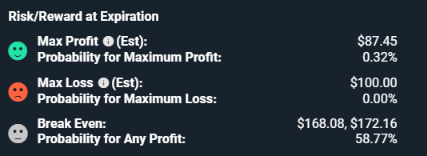Option Trading Is Almost Always a Trade-Off
When I talk about options, which is quite often, I like to say that everything in options is a trade-off. As I tell my students, if you give up this, you get that in return and vice versa. If you have a better risk/reward trade, the probability of a profit is lessened and vice versa. But lately I have found an exception or two, especially when it comes to time spreads.
Different Ways to Profit
Synthetically, vertical debit and credit spreads are the same. Many traders sell out-of-the-money (OTM) credit spreads. Why does this trade have a seemingly unfair risk/reward? In other words, why are you risking a lot more than you are willing to make? The answer is that the odds are on your side to profit so the risk is higher.
If a stock is trading at $82 and you sell an 80-strike put and buy a 75-strike put creating a bull put spread, you have three ways to profit at expiration. The stock can move higher, trade sideways or move lower. As long as the stock closes at $80 or higher at expiration, maximum profit is realized.
If you bought an at-the-money (ATM) or in-the-money (ITM) vertical debit spread, the risk/reward ratio would be closer to even. If a stock was at $81 and you bought an 80-strike call and sold an 85-strike call to create a bull call spread, you really have only one way to profit at expiration. The stock would need to move higher than the breakeven of the trade. There are not three out of four ways to profit as with the bull put spread, which means the risk is equal to the reward. It is a trade-off.
Long Put Calendar Example
What I have found when it comes to time spreads, like long calendars, is that if you go further out to expiration on the long option, the cost and risk increase, but the max profit and breakevens are not much better. Granted, the max profit and breakevens are guesstimates because of different expirations, but still.
Take a look at the long 170 put calendar examples below. The first is buying the next expiration after the short expiration and the second is buying one additional week longer. Notice the cost goes up but the max profit and breakevens are not any better for the second compared with the first.


Change Is Inevitable
OK, so I have changed my tune a little bit to now say almost everything in options is a trade-off. Option traders should always think about what changes if different trades are modelled. There is almost always something that will change, and you need to realize what that is. Have fun trading!
John Kmiecik, Market Taker Mentoring
